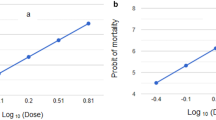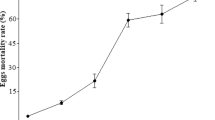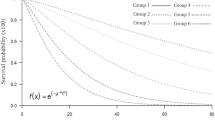Abstract
The tomato leafminer, Tuta absoluta (Meyrick) is a destructive pest of tomato, potato and other solanaceous crops of economic importance. One of the primary tools in its management is the use of conventional synthetic insecticides; however, this overreliance on synthetic insecticides quickly leads to the problem of insecticide resistance. In recent years, essential oils (EOs) of medicinal plants have received much attention as pest control chemical agents. If found, active compounds that are less persistent will be beneficial for both the environment and agricultural product consumers. In the current study, we studied the fumigant toxicity of EO of the Shirazi thyme, Zataria multiflora Boiss on the eggs, the second larval instars and adults. We analysed the composition of the EO by gas chromatography—mass spectrometry. The major component in the oil was thymol (33.52%). The EO showed strong adulticidal, larvicidal and ovicidal activity. Results show that by increasing the oil concentration, mortality will increase. By Probit analysis, the LC50 values for eggs, second larvae (inside leaf, outside leaf) and adults were 60.26, 4.44, 1.26 and 1.38 μl/L air, respectively. The EO of Z. multiflora may be suitable as a fumigant, because of its high volatility and safety.
Similar content being viewed by others
References
Adams R. P. (ed.) (2007) Identification of Essential Oil Components by Gas Chromatography/Mass Spectrometry, 4th edn. Allured Publishing Corporation, IL, USA. 804 pp.
Ahn Y.-J., Lee S.-B., Lee H.-S. and Kim G.-H. (1998) Insecticidal and acaricidal activity of carvacrol and β-thujaplicine derived from Thujopsis dolabrata var. hondai sawdust. Journal of Chemical Ecology 24, 81–90.
Ali M. S., Saleem M., Ali Z. and Ahmad V. U. (2000) Chemistry of Zataria multiflora (Lamiaceae). Phytochemistry 55, 933–936.
Apablaza J. (1992) La polilla del tomate y su manejo. Tattersal 79, 12–13.
Baniameri V. and Cheraghian A. (2012) The first report and control strategies of Tuta absoluta in Iran. EPPO Bulletin 42, 322–324.
Barrientos R. Z., Apablaza J. H., Norero A. S. and Estay P. P. (1998) Threshold temperature and thermal constant for the development of the South American tomato moth, Tuta absoluta (Lepidoptera: Gelechiidae). Ciencia e Investigacion Agraria 25, 133–137 (in Spanish).
Desneux N., Luna M. G., Guillemaud T. and Urbaneja A. (2011) The invasive South American tomato pinworm, Tuta absoluta, continues to spread in Afro-Eurasia and beyond: The new threat to tomato world production. Journal of Pest Science 84, 403–408.
Duke J. A. (1985) CRC Handbook of Medicinal Herbs. CRC Press, Boca Roton Florida, USA. 677 pp.
Ebrahimzadeh H., Yamini Y., Sefidkon F., Chaloosi M. and Pourmortazavi S. M. (2003) Chemical composition of the essential oil and supercritical CO2 extracts of Zataria multiflora Boiss. Food Chemistry 83, 357–361.
Emamjomeh L., Imani S., Talebi K., Moharramipour S. and Larijani K. (2014) Chemical composition and insecticidal activity of essential oil of Zataria multiflora Boiss. (Lamiaceae) against Ephestia kuehniella (Lepidoptera: Pyralidae). European Journal of Experimental Biology 4, 253–257.
Galarza J. (1984) Laboratory assessment of some solanaceous plants as possible food-plants of the tomato moth Scrobipalpula absoluta (Meyr.) (Lepidoptera: Gelechiidae). IDIA 421/424, 30–32.
Guedes R. N. C. and Picanco M. C. (2012) The tomato borer Tuta absoluta in South America: Pest status, management and insecticide resistance. EPPO Bulletin 42, 211–216.
Guedes R. N. C. and Siqueira H. A. A. (2012) The tomato pinworm Tuta absoluta: Insecticide resistance & control failure. CAB Reviews Perspectives in Agriculture, Veterinary Science, Nutrition and Natural Resources 7, 055.
Haddi K., Berger M., Bielza P., Cifuentes D., Field L. M., Gorman K., Rapisarda C., Williamson M.S. and Bass C. (2012) Identification of mutations associated with pyrethroid resistance in the voltage-gated sodium channel of the tomato leaf miner (Tuta absoluta). Insect Biochemistry and Molecular Biology 42, 506–513.
Kéita S. M., Vincent C., Schmit J.-P., Ramaswamy S. and Belanger A. (2000) Effect of various essential oils on Callosobruchus maculatus (F.) (Coleoptera: Bruchidae). Journal of Stored Products Research 36, 355–364.
Lambert R. J. W., Skandamis P. N., Coote P. J. and Nychas G. J. (2001) A study of the minimum inhibitory concentration and mode of action of oregano essential oil, thymol and carvacrol. Journal of Applied Microbiology 91, 453–462.
Lee S., Peterson C. J. and Coats J. R. (2003) Fumigation toxicity of monoterpenoids to several stored product insects. Journal of Stored Products Research 39, 77–85.
Lietti M. M., Botto E. and Alzogaray R. A. (2005) Insecticide resistance in Argentine populations of Tuta absoluta (Meyrick) (Lepidoptera: Gelechiidae). Neotropical Entomology 34, 113–119.
Mahmoudvand M., Abbasipour H., Basij M., Hosseinpour M. H., Rastegar F. and Nasiri M. B. (2011) Fumigant toxicity of some essential oils on adults of some storedproduct pests. Chilean Journal of Agricultural Research 71, 83–89.
Meyrick E. (1917) I. Descriptions of South American micro-Lepidoptera. Transactions of the Royal Entomological Society of London 65, 1–52.
Misaghi A. and Akhondzadeh Basti A. (2007) Effects of Zataria multiflora Boiss. essential oil and nisin on Bacillus cereus ATCC 11778. Food Control 18, 1043–1049.
Motazedian N., Aleosfoor M., Davoodi A. and Bandani A. R. (2014) Insecticidal activity of five medicinal plant essential oils against the cabbage aphid, Brevicoryne brassicae. Journal of Crop Protection 3, 137–146.
Mozzaffarian V. (1998) A Dictionary of Iranian Plant Names. Farhang Mo’aser Publication, Tehran, Iran. 739 pp.
Muszinski T., Lavendowski I. M. and de Maschio L. M. A. (1982) Observation of Scrobipalpula absoluta (Meyrick, 1917) (= Gnorimoschema absoluta), as a pest of tomatoes (Lycopersicon esculentum Mill.), at the Paraná seaside. Anais da Sociedade Entomológica do Brasil 11, 291–292 (in Portuguese).
Negahban M., Moharramipour S. and Sefidkon F. (2007) Fumigant toxicity of essential oil from Artemisia sieberi Besser against three stored-product insects. Journal of Stored Products Research 43, 123–128.
Notz A. P. (1992) Distribution of eggs and larvae of Scrobipalpula absoluta in potato plants. Revista de la Facultad de Agronomia (Maracay) (in Spanish) 18, 425–432.
Picanço M. C., Bacci L., Crespo A. L. B., Miranda M. M. M. and Martins J. C. (2007) Effect of integrated pest management practices on tomato production and conservation of natural enemies. Agricultural and Forest Entomology 9, 327–335.
Prabakar K. and Jebanesan A. (2004) Larvicidal efficacy of some cucurbitaceous plant leaf extracts against Culex quinquefasciatus (Say). Bioresource Technology 95, 113–114.
Prakash A. and Rao J. (1997) Botanical Pesticides in Agriculture. CRC Press, Inc., Boca Raton, Florida, USA. 480 pp.
Rastegar F., Moharramipour S., Shojai M. and Abbasipour H. (2011) Chemical composition and insecticidal activity of essential oil of Zataria multiflora Boiss. (Lamiaceae) against Callosobruchus maculatus (F.) (Coleoptera: Bruchidae). IOBC/wprs Bulletin 69, 281–288.
Regnault-Roger C. and Hamraoui A. (1995) Fumigant toxic activity and reproductive inhibition induced by monoterpenes on Acanthoscelides obtectus (Say) (Coleoptera), a bruchid of kidney bean (Phaseolus vulgaris L.). Journal of Stored Products Research 31, 291–299.
Robertson J. L., Russell R. M., Preisler H. K. and Savin N. E. (2007) Bioassays with Arthropods. CRC Press, Boca Raton, Florida, USA. 224 pp.
Roditakis E. and Seraphides N. (2011) The current status of Tuta absoluta in Greece and Cyprus, p. 19. In Abstracts of Presentations. Proceedings of the EPPO/IOBC/FAO/NEPPO Joint International Symposium on Management of Tuta absoluta (tomato borer, Lepidoptera: Gelechiidae) in Collaboration with the IRAC and IBMA). 16–18 November, Agadir, Morocco. Available at: https://doi.org/archives.eppo.int/MEETINGS/2011_conferences/tuta/brochure_tuta.pdf.
Roditakis E., Papachristos D. and Roditakis N. E. (2010) Current status of the tomato leafminer, Tuta absoluta in Greece. EPPO Bulletin 40, 163–166.
Sadeghi H., Robati Z. and Saharkhiz M. J. (2015) Variability in Zataria multiflora Bioss. essential oil of twelve populations from Fars Province, Iran. Industrial Crops and Products 67, 221–226.
SAS Institute Inc. (2004) SAS/STAT® 9.1 User’s Guide. SAS Institute, Cary, NC.
Schmutterer H. (1992) Control of diamondback moth by application of neem extracts, pp. 325–332. In The Managment of Diamondback Moth and other Crucifer Pests (edited by N. S. Talekar). AsianVegetable Research and Development Centre, Tainan, Taiwan.
Sharififar F., Moshafi M. H., Mansouri S. H., Khodashenas M. and Khoshnoodi M. (2007) In vitro evaluation of antibacterial and antioxidant activities of the essential oil and methanol extract of endemic Zataria multiflora Boiss. Food Control 18, 800–805.
Silva G. A., Picanco M. C., Bacci L., Crespo A. L. B., Rosado J. F. and Guedes R. N. C. (2011) Control failure likelihood and spatial dependence of insecticide resistance in the tomato pinworm, Tuta absoluta. Pest Management Science 67, 913–920.
Siqueira H. A. A., Guedes R. N. C., Fragoso D. B. and Magalhaes L. C. (2001) Abamectin resistance and synergism in Brazilian populations of Tuta absoluta (Meyrick) (Lepidoptera: Gelechiidae). International Journal of Pest Management 47, 247–251.
Tomé H. V. V., Cordeiro E. M. G., Rosado J. F. and Guedes R. N. C. (2012) Egg exposure to pyriproxyfen in the tomato leaf miner, Tuta absoluta: Ovicidal activity or behavioural-modulated hatching mortality? Annals of Applied Biology 160, 35–42.
Tropea Garzia G., Siscaro G., Biondi A. and Zappala L. (2012) Tuta absoluta, a South American pest of tomato now in the EPPO region: Biology, distribution and damage. EPPO Bulletin 42, 205–210.
Umpierre M. L., Lagreca M. E., Cabrera R., Grille G. and Rossini C. (2012) Essential oils from Asteraceae as potential biocontrol tools for tomato pests and diseases. Phytochemistry Reviews 11, 339–350.
Zandi-Sohani N. (2012) Acomparative study on fumigant toxicity of Zataria multiflora and Satureja hortensis (Lamiaceae) to Callosobruchus maculatus (Coleoptera: Chrysomelidae). International Journal of Tropical Insect Science 32, 142–147.
Zappalà L., Biondi A., Alma A., Al-Jboory J., Arno J., Bayram A., Chailleux A., El-Arnaouty A., Gerling D., Guenaoui Y., Shaltiel-Harpaz L., Siscaro G., Stavrinides M., Tavella L., Vercher Aznar R., Urbaneja A. and Desneux N. (2013) Natural enemies of the South American moth, Tuta absoluta, in Europe, North Africa and Middle East, and their potential use in pest control strategies. Journal of Pest Science 86, 635–647.
Zargari A. (1993) Medicinal Plants, Vol. 4. Tehran University Press, Tehran. 970 pp.
Zhao J., Davis L. C. and Verpoorte R. (2005) Elicitor signal transduction leading to production of plant secondary metabolites. Biotechnology Advances 23, 283–333.
Author information
Authors and Affiliations
Corresponding author
Rights and permissions
About this article
Cite this article
Chegini, S.G., Abbasipour, H., Karimi, J. et al. Toxicity of Shirazi thyme, Zataria multiflora essential oil to the tomato leaf miner, Tuta absoluta (Lepidoptera: Gelechiidae). Int J Trop Insect Sci 38, 340–347 (2018). https://doi.org/10.1017/S1742758418000097
Accepted:
Published:
Issue Date:
DOI: https://doi.org/10.1017/S1742758418000097




